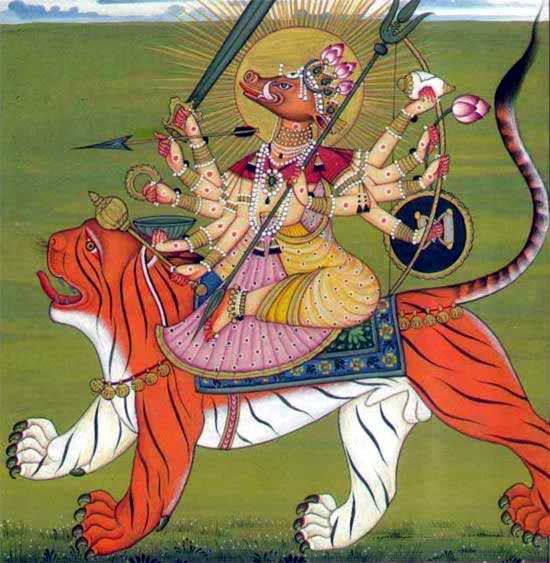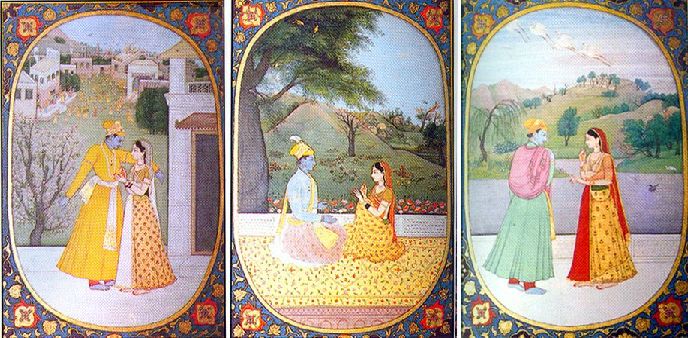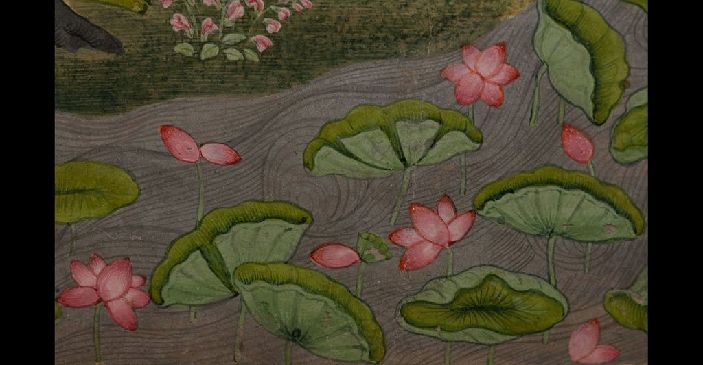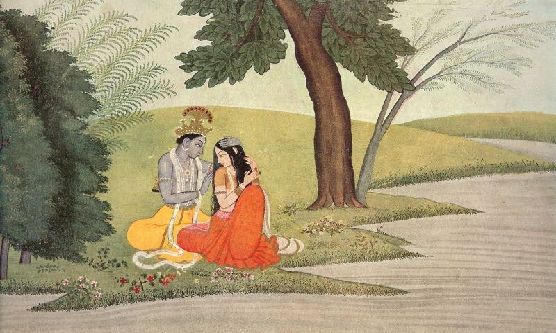Pahari Paintings
Sep 25, 2019 • 433 views
History and Origin
Originated in the sub-Himalayan region of India, the extreme flourishment of Pahari paintings was seen for a long period of about two hundred years, spanning from 17th -19th century. Patronized mostly by Rajput Kings, these paintings are often said to be inspired by Mughal paintings which were spread and promoted by the Mughal emperors. The influence of paintings from Gujarat and Deccan can also be seen in them. The main regions which saw the development of Pahari paintings include the states of Himachal Pradesh and Jammu and Kashmir. Small sections of Punjab which are closer to the Himalayan region and Garhwal in Uttar Pradesh (now Uttarakhand) are also the centres of Pahari paintings. They are a form of miniature paintings which is one of the most common features in a number of paintings that have developed in India.

Pahari Painting - Source: Harekrsna
Schools of Pahari Paintings
Depending upon the regions that the art form developed in, Pahari paintings are divided into four different schools. All of them, though come under the same type of paintings, they have their own unique features, whether it is with respect to the colors or techniques of the paintings. From the bold and intense paintings of Basohli in Jammu and Kashmir to the mild and mellifluous Kangra paintings, all are distinct and beautiful in their own way. The schools of Pahari paintings are -
Basohli School - Bold, expressive, unconventional, zealous are the few words that aptly describe what basohli paintings are all about. Developed in the western foothills of Punjab state and Jammu and Kashmir, kathua to be particular, the earliest evidence of the existence of these paintings date back to the rule of Raja Kirpal Pal (1678 - 93). Basohli style paintings are characterized by bold designs, heightened facial features, strong contrasting colors, and rich, imaginative execution.

Basohli Style Painting - Source: Hindu Scriptures
Guler School - Often referred to as the predecessor of the Kangra style of painting, this school is the early phase of Kangra Kalam. These paintings have delicateness in them and express serenity and spirituality. This style developed during the mid-eighteenth century when some Hindu artists who were trained in the Mughal style of painting came to seek patronage from the Rajas of Guler. The use of mild, soothing colors and execution that is nothing but precise, make it different than all other forms of Pahari painting.
Kangra School - This school of painting came into existence by the end of the eighteenth century and is considered the third phase of Kangra Kalam. Being the successor of the Guler style of painting, it has taken a lot of features from it. The delicate, lyrical and spiritual nature of Guler school of paintings is seen in Kangra school too. The name of this school has a history behind it. The portraits of Raja Sansar Chand of Kangra acted as the models for this style of paintings, thus giving it the name Kangra. Certain features of the Kangra school of painting include the nose of the women in the drawings being in line with the forehead, long nose, and other sharp features. Kangra school is the most famous out of all the schools of Pahari paintings.

Kangra Style Painting - Source: Royal Kangra
Chamba School - This school came into existence when basohli painting artists moved from Guler to Chamba. During the eighteenth century, Raja Jai Singh and Raja Udai Singh acted as patrons for this style of painting. It is during the reign of Raja Charhat Singh that this style grew popular and influenced the local artisans. A clear influence of Mughal art can be seen in these paintings. some paintings are preserved in museums of Chamba, Shimla, and Dharamsala.
Types and Styles
Apart from the broader distinctions of different schools of Pahari painting, the art form is further divided into a number of types and styles. Some of these include -
Mankot paintings belong to Jammu and Kashmir regions. They are quite similar to the Basohli style of paintings with respect to their use of bold colors and strong execution.
Mandi paintings is the style that began in the Mandi district of Himachal Pradesh by the end of the seventeenth century. These paintings can be characterized by exaggerated features in the portraits of kings and geometric designs in other paintings.
Themes, Inspiration and Significant Elements
Pahari paintings derive their central themes from the feelings and incidences of human life. The scenic beauty of the mountains, the poetry, the folklores, and the songs, Pahari paintings carry the essence of all these things in them. Intricacy and detailing are given special attention in the paintings. Scenes from mythological tales are one of the common and yet beautiful depictions that can be seen in many Pahari paintings. Whether it is Bhagavad Gita or Ramayana, these paintings have captured the essence of all. Paintings depicting Radha and Krishna are the most popular ones. Apart from religious themes, these paintings also cover everyday life, the kings and queens, love stories and wars, and all things that were a part of the region in which they originated.

Flora Themed Pahari Painting - Source: YouTube

Radha and Krishna Themed Painting - Source: Siva Travelogue
Present Day Scenario
The Pahari paintings saw a decrease in their popularity with the decline in patronage and local arts during the British Raj. In the present times, though this art form is not very prominent in its authentic sense, but can still be seen in various modern forms. From wall hangings to fabrics, Pahari paintings are being promoted in different ways. Like any other traditional art form, these paintings will lose their significance and will be forever lost in the pages of history if nothing is done to expand and bring them back into the popular culture.
